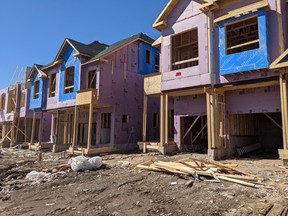
The fight between the Ford government and Ontario’s municipalities over development charges is really a fight over the goose that laid the golden egg.
Municipalities are afraid the Ford government is taking away an easy revenue source in a bid to make housing more affordable.
As the Canadian national soccer teams head to their respective FIFA World Cups, Derek Van Diest is on the scene to cover all the action. Expect expert insights and analysis in your inbox daily throughout the tournaments, and weekly on Thursdays for the rest of the season.
Thanks for signing up!
A welcome email is on its way. If you don't see it, please check your junk folder.
The next issue of Corner Kicks with Derek Van Diest will soon be in your inbox.
According to the Association of Municipalities of Ontario, the changes brought about by the Ford government could take as much as $1 billion out of the coffers of municipalities annually over the next eight years. Put another way, municipalities won’t be driving up the cost of affordable or attainable housing with high development fees.
It really is all in how you look at the situation.
Development fees in Ontario, especially our major cities around the GTA and in Ottawa, are not only some of the highest in Canada, they are also some of the highest in North America. A study from Altus Group, an international real estate consulting firm commissioned by the Building Industry and Land Development Association (BILD), shows just how bad the situation is in Ontario.
The municipal charges for a lowrise housing unit, that being a single-family home or a home in a smaller apartment or condo unit, sit at an average of $116,900 per unit. That ranges from $189,325 in Toronto to $113,635 in Oakville and $84,966 in Oshawa.
In Ottawa, the total municipal charge for an apartment or condo unit in a highrise building of 20 storeys or more is $85,745 per unit. That’s a 202% increase compared to the same cost in 2020.
RECOMMENDED VIDEO
As advocates at the municipal level are telling housing developers to build up, not out, the municipal charges are actually making that option less affordable. While the overall cost of a lowrise home is lower in most municipalities, the price per square foot is much higher for highrise units meaning the price incentive makes building lowrise homes more attractive.
In Toronto the cost per square foot on a lowrise build is $85 but jumps to $125 on a highrise. In Vaughan, the lowrise price is $76 but jumps to $152 for a highrise. In Ottawa, which recently increased their development and other municipal charges significantly, the lowrise cost per square foot is $18 but jumps to $116 per square foot for a highrise.
It’s more than development charges, which the Ford government’s Bill 23 deals with when it comes to affordable and attainable homes, it’s also cash-in-lieu of parkland, it’s community benefits charges, GO Transit charges for developers in the GTA, school development charges.
One study from the Altus Group in September 2019 put the total cost of development charges in the GTA between 9-12% of the total cost of a home. The total cost of all government charges for a new home including HST, land transfer taxes and more was over 20% of the total price.
RECOMMENDED VIDEO
Since that study, major municipalities such as Toronto, Ottawa, Mississauga and others have increased their fees dramatically. These municipalities have treated development fees, which are only passed on to new home buyers, as a cash cow. It has allowed municipalities to increase revenues by forcing new home buyers to pay a disproportionate share of infrastructure costs while keeping taxes lower than they would otherwise be set at.
A study by BILD, again conducted by Altus Group, puts forward the idea that the changes on what municipalities can charge for affordable or attainable housing will amount to less than 1% of their annual income. As anyone who has run a large organization can tell you, finding a savings of 1% is the easy part.
Municipalities have become too reliant on development and other charges, fees that only drive up the cost of housing for those who can least afford it. Bill 23 is an attempt to fix that.
Municipal leaders would be wise to embrace it, not fight it.
blilley@postmedia.com


